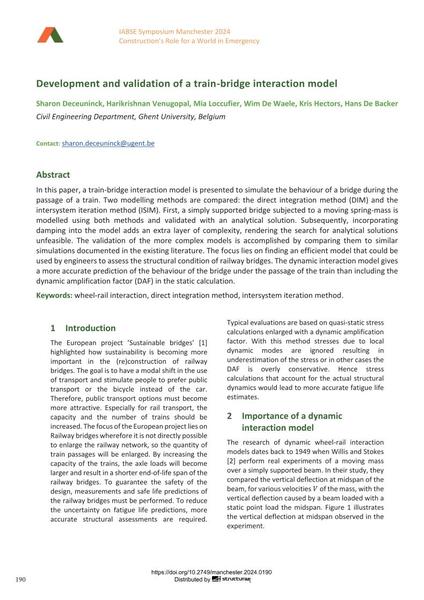Development and validation of a train-bridge interaction model

|
|
|||||||||||
Bibliographic Details
| Author(s): |
Sharon Deceuninck
(Civil Engineering Department, Ghent University, Belgium)
Mia Loccufier (Civil Engineering Department, Ghent University, Belgium) Wim De Waele (Civil Engineering Department, Ghent University, Belgium) Kris Hectors (Civil Engineering Department, Ghent University, Belgium) Hans De Backer (Civil Engineering Department, Ghent University, Belgium) |
||||
|---|---|---|---|---|---|
| Medium: | conference paper | ||||
| Language(s): | English | ||||
| Conference: | IABSE Symposium: Construction’s Role for a World in Emergency, Manchester, United Kingdom, 10-14 April 2024 | ||||
| Published in: | IABSE Symposium Manchester 2024 | ||||
|
|||||
| Page(s): | 190-198 | ||||
| Total no. of pages: | 9 | ||||
| DOI: | 10.2749/manchester.2024.0190 | ||||
| Abstract: |
In this paper, a train-bridge interaction model is presented to simulate the behaviour of a bridge during the passage of a train. Two modelling methods are compared: the direct integration method (DIM) and the intersystem iteration method (ISIM). First, a simply supported bridge subjected to a moving spring-mass is modelled using both methods and validated with an analytical solution. Subsequently, incorporating damping into the model adds an extra layer of complexity, rendering the search for analytical solutions unfeasible. The validation of the more complex models is accomplished by comparing them to similar simulations documented in the existing literature. The focus lies on finding an efficient model that could be used by engineers to assess the structural condition of railway bridges. The dynamic interaction model gives a more accurate prediction of the behaviour of the bridge under the passage of the train than including the dynamic amplification factor (DAF) in the static calculation. |
||||
| Keywords: |
wheel-rail interaction direct integration method intersystem iteration method
|
||||
